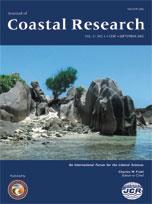Optically stimulated luminescence ages were done on beach ridge samples from the Cape Peninsula, Merritt Island, and a mainland location in Brevard County, Florida. Age estimates on the peninsula ranged from 4000 to 150 years ago; while on Merritt Island, a beach-ridge sample yielded an age of about 43,000 years ago. The mainland sample, near Titusville, gave an age of about 8000 years. Using the age estimates for four ridges on the Canaveral Peninsula, average land accretion rates and beach-ridge accumulation rates were determined by measuring distances perpendicular to strike of the ridge sequences and counting ridges along these trends. The average ridge spacing was found to be 109 ± 20 m, the average ridge accumulation rate was 80 ± 8 y/ridge, and the average land accretion rate was found to be 135 ± 12 m per hundred years. We suggest that the ridge accumulation rate can be used to determine storm recurrence intervals on the peninsula. The peninsular age estimates show the problems associated with radio-carbon dating of shell, which overestimate burial ages by several thousand years due to reworking of older shell into younger deposits.
How to translate text using browser tools
1 September 2005
Dating Evidence for the Accretion History of Beach Ridges on Cape Canaveral and Merritt Island, Florida, USA
W. J. Rink,
B. Forrest
ACCESS THE FULL ARTICLE
accretion rates
beach ridge
land accretion
luminescence ages
Peninsular age
ridge sequences





